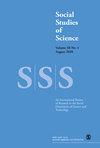The extractive loops of biocapital: Venom procurement and antivenom production in India.
IF 2.7
2区 社会学
Q1 HISTORY & PHILOSOPHY OF SCIENCE
引用次数: 0
Abstract
A growing body of research and scholarship has examined the exploitation of animals by the biopharmaceutical industry, framing it variously in terms of labour, commodification, or hybrid processes. This article adds to the discussion through an ethnography of antivenom manufacturing in India. It introduces the concept of 'extractive loops' embedding species, locations, and work practices. Extractive loops form a continuum through which non-human life contributes to the manufacturing of resources (raw materials and finished products). The argument relies on a description of the operations required by the production of antivenom, involving: (a) several animal species (mostly snakes, horses, and rodents), (b) connections between a multiplicity of locations, from outdoor fields to industrial sites, (c) a wide range of professional practices, some of them strictly formalized whereas others are mainly informal (such as snake catching), and (d) heterogeneous exploitation of non-human life and products. Extractive loops highlight a key feature of animal exploitation: a recurring series of extractive practices contributing to the continuous fabrication of natural resources.生物资本的提取循环:印度的蛇毒采购和抗蛇毒血清生产。
越来越多的研究和学术机构研究了生物制药行业对动物的剥削,从劳动力、商品化或混合过程的角度对其进行了不同的界定。这篇文章通过印度抗蛇毒血清制造的民族志增加了讨论。它引入了嵌入物种、地点和工作实践的“提取循环”概念。提取循环形成一个连续体,非人类生命通过这个连续体为资源(原材料和成品)的制造做出贡献。该论点依赖于对生产抗蛇毒血清所需操作的描述,涉及:(a)几种动物物种(主要是蛇、马和啮齿动物),(b)从户外田野到工业场所等多个地点之间的联系,(c)广泛的专业实践,其中一些是严格正式的,而另一些则主要是非正式的(如捕蛇),以及(d)对非人类生命和产品的异质开发。采掘循环强调了动物剥削的一个关键特征:一系列重复的采掘行为促进了自然资源的不断制造。
本文章由计算机程序翻译,如有差异,请以英文原文为准。
求助全文
约1分钟内获得全文
求助全文
来源期刊

Social Studies of Science
管理科学-科学史与科学哲学
CiteScore
5.70
自引率
6.70%
发文量
45
审稿时长
>12 weeks
期刊介绍:
Social Studies of Science is an international peer reviewed journal that encourages submissions of original research on science, technology and medicine. The journal is multidisciplinary, publishing work from a range of fields including: political science, sociology, economics, history, philosophy, psychology social anthropology, legal and educational disciplines. This journal is a member of the Committee on Publication Ethics (COPE)
 求助内容:
求助内容: 应助结果提醒方式:
应助结果提醒方式:


